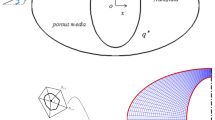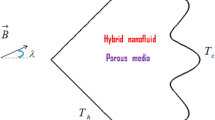Abstract
Numerical approach has been employed to model the effect of permeability and Lorentz terms on buoyant flow of nanomaterial within a tank with one sinusoidal hot element. Although managing the system in thermal view is important, scrutinizing the irreversibility should be considered to reach the optimized unit. CVFEM with involving vorticity formulation was selected and sources terms of Lorentz and permeability was involved in vorticity transportation. Outcomes were summarized in terms of 3D distributions for Nu, Be and contours. Although increasing Ha leads to higher temperature of inner wavy wall, temperature gradient reduces which causes Nu to reduce and Be to increase. These effects are attributed to lower strength of circulation cell with rise of Ha which makes isotherms become parallel to each other and friction factor do not allow the nanomaterial to move faster inside the tank. With reduce of Da, resistance term becomes superior than convection term and nano particles cannot migrate easier and consequently Nu declines with reduce of permeability. Lower Da leads to higher share of Sgen,th and Be increases and same trend was reported for Ra. Stronger buoyancy force cause more complex isotherms and temperature of hot elements declines, so Nu enhances while reduction in temperature gradient leads to lower Be. Although augment of Ha can enhance the Be about 17.9% while it makes Nu to reduce about 24.7%. As Ra augments, Be declines about 75.22% while Nu for greater Ra is 2.79 times greater than that of Ra = 103. Temperature of inner wall declines about 62.5% and 25% with growth of Ra and Da, respectively. Besides, as Ha increases, temperature augments about 33.33%. Sgen,th declines about 18.18% with rise of Ra.










Similar content being viewed by others
References
Aly AM, Raizah ZAS (2020) Incompressible smoothed particle hydrodynamics simulation of natural convection in a nanofluid-filled complex wavy porous cavity with inner solid particles. Phys A 537:122623
Chen H, Fan D, Huang J, Huang W, Zhang G, Huang L (2020) Finite element analysis model on ultrasonic phased array technique for material defect time of flight diffraction detection. Sci Adv Mater 12(5):665–675. https://doi.org/10.1166/sam.2020.3689
Chu Y-M, Moradi R (2020) Amir Musa Abazari, Quang-Vu Bach, Effect of non-uniform magnetic field on thermal performance of nanofluid flow in angled junction. Int J Mod Phys C. https://doi.org/10.1142/S0129183121500017
Chu Y-M, Yadav D, Ahmad Shafee Z, Li Q-V (2020) Influence of wavy enclosure and nanoparticles on heat release rate of PCM considering numerical study. J Mole Liquids 319:114121. https://doi.org/10.1016/j.molliq.2020.114121
Chu Y-M, Hajizadeh MR, Bach Q-V (2020) Investigation of nano powders influence on melting process within a storage unit. J Mole Liquids 318:114321. https://doi.org/10.1016/j.molliq.2020.114321
Chu Y-M, Abu-Hamdeh NH, Ben-Beya B, Hajizadeh MR, Li Z, Bach Q-V (2020) Nanoparticle enhanced PCM exergy loss and thermal behavior by means of FVM. J Mole Liquids 320:114457
Gao N, Cheng B, Hou H, Zhang R (2018) Mesophase pitch based carbon foams as sound absorbers. Mater Lett 212:243–246. https://doi.org/10.1016/j.matlet.2017.10.074
Hashim I, Alsabery A, Sheremet M, Chamkha A (2019) Numerical investigation of natural convection of Al2O3-water nanofluid in a wavy cavity with conductive inner block using Buongiorno’s two-phase model. Adv Powder Technol 30(2):399–414
He L, Liu J, Liu Y, Cui B, Hu B, Wang M, Du M (2019) Titanium dioxide encapsulated carbon-nitride nanosheets derived from MXene and melamine-cyanuric acid composite as a multifunctional electrocatalyst for hydrogen and oxygen evolution reaction and oxygen reduction reaction . Appl Cata Environ 248:366–379. https://doi.org/10.1016/j.apcatb.2019.02.033
Khanafer K, Vafai K, Lightstone M (2003) Buoyancy-driven heat transfer enhancement in a two-dimensional enclosure utilizing nanofluids. Int J Heat Mass Transf 46(19):3639–3653
Liao Q, Wei W, Zuo H, Li X, Yang Z, Xiao S, Wu G (2020) Interfacial bonding enhancement and properties improvement of carbon/copper composites based on nickel doping. Compos Interfaces. https://doi.org/10.1080/09276440.2020.1798681
Lin J, Cai X, Liu Z, Liu N, Xie M, Zhou B, Guo Z (2020) Anti-liquid-interfering and bacterially antiadhesive strategy for highly stretchable and ultrasensitive strain sensors based on Cassie-Baxter Wetting State. Adv Func Mater 30(23):2000398. https://doi.org/10.1002/adfm.202000398
Liu Q, Song Z, Han H, Donkor S, Jiang L, Wang W, Chu H (2020) A novel green reinforcement corrosion inhibitor extracted from waste Platanus acerifolia leaves. Const Building Mater 260:119695. https://doi.org/10.1016/j.conbuildmat.2020.119695
Lund LA, Omar Z, Khan I (2019) Quadruple solutions of mixed convection flow of magnetohydrodynamic nanofluid over exponentially vertical shrinking and stretching surfaces: stability analysis. Comput Methods Programs Biomed 182:105044
Luo X, Hu H, Pan Z, Pei F, Qian H, Miao K, Feng G (2020) Efficient and stable catalysis of hollow Cu9S5 nanospheres in the Fenton-like degradation of organic dyes. J Hazard Mater 396:122735. https://doi.org/10.1016/j.jhazmat.2020.122735
Manh TD, Nam ND, Abdulrahman GK, Moradi R, Babazadeh H (2019) Impact of MHD on hybrid nanomaterial free convective flow within a permeable region. J Ther Analy Calor. https://doi.org/10.1007/s10973-019-09008-8
Mansour M, Ahmed SE (2015) A numerical study on natural convection in porous media-filled an inclined triangular enclosure with heat sources using nanofluid in the presence of heat generation effect. Eng Sci Technol Internat J 18(3):485–495
Reddy PS, Rao KVS (2015) MHD natural convection heat and mass transfer of Al2O3-water and Ag-Water nanofluids over a vertical cone with chemical reaction. Proc Eng 127:476–484
Selimefendigil F, Öztop HF (2019) Fluid-solid interaction of elastic-step type corrugation effects on the mixed convection of nanofluid in a vented cavity with magnetic field. Int J Mech Sci 152:185–197
Sheikholeslami M (2018) Magnetic source impact on nanofluid heat transfer using CVFEM. Neural Comput Appl 30(4):1055–1064
Sheikholeslami M, Farshad SA (2021) Nanoparticle transportation inside a tube with quad-channel tapes involving solar radiation. Powder Technol 378:145–159
Sheikholeslami M, Jafaryar M, Said Z, Alsabery AI, Babazadeh H, Shafee A (2020) Modification for helical turbulator to augment heat transfer behavior of nanomaterial via numerical approach. Appl Therm Eng 182:115935
Sheremet MA, Cimpean DS, Pop I (2017) Free convection in a partially heated wavy porous cavity filled with a nanofluid under the effects of Brownian diffusion and thermophoresis. Appl Therm Eng 113:413–418
Sheremet MA, Revnic C, Pop I (2017) Free convection in a porous wavy cavity filled with a nanofluid using Buongiorno’s mathematical model with thermal dispersion effect. Appl Math Comput 299:1–15
Shi M, Narayanasamy M, Yang C, Zhao L, Jiang J, Angaiah S, Yan C (2020) 3D interpenetrating assembly of partially oxidized MXene confined Mn–Fe bimetallic oxide for superior energy storage in ionic liquid. Electrochim Acta 334:135546. https://doi.org/10.1016/j.electacta.2019.135546
Song Q, Zhao H, Jia J, Yang L, Lv W, Bao J, Zhang P (2020) Pyrolysis of municipal solid waste with iron-based additives: a study on the kinetic, product distribution and catalytic mechanisms. J Cleaner Prod 258:120682. https://doi.org/10.1016/j.jclepro.2020.120682
Song Q, Zhao H, Jia J, Yang L, Lv W, Gu Q, Shu X (2020) Effects of demineralization on the surface morphology, microcrystalline and thermal transformation characteristics of coal. J Anal Appl Pyrol 145:104716. https://doi.org/10.1016/j.jaap.2019.104716
Sun Q, Pop I (2011) Free convection in a triangle cavity filled with a porous medium saturated with nanofluids with flush mounted heater on the wall. Int J Therm Sci 50(11):2141–2153
Wang W, Guo J, Long C, Li W, Guan J (2015) Flaky carbonyl iron particles with both small grain size and low internal strain for broadband microwave absorption. J Alloy Compd 637:106–111. https://doi.org/10.1016/j.jallcom.2015.02.220
Xu H, Wang T, Qu Z, Chen J, Li B (2017) Lattice Boltzmann simulation of the double diffusive natural convection and oscillation characteristics in an enclosure filled with porous medium. Int Commun Heat Mass Transfer 81:104–115
Yu X, Zhang J, Zhang J, Niu J, Zhao J, Wei Y, Yao B (2019) Photocatalytic degradation of ciprofloxacin using Zn-doped Cu2O particles: analysis of degradation pathways and intermediates. Chem Eng J 374:316–327. https://doi.org/10.1016/j.cej.2019.05.177
Yu H, He Z, Qian G, Gong X, Qu X (2020) Research on the anti-icing properties of silicone modified polyurea coatings (SMPC) for asphalt pavement. Constr Build Mater 242:117793. https://doi.org/10.1016/j.conbuildmat.2019.117793
Yu H, Zhu X, Qian G, Gong X, Nie X (2020) Evaluation of phosphorus slag (PS) content and particle size on the performance modification effect of asphalt. Constr Build Mater 256:119334. https://doi.org/10.1016/j.conbuildmat.2020.119334
Zhang Y, Zhang X, Li M, Liu Z (2019) Research on heat transfer enhancement and flow characteristic of heat exchange surface in cosine style runner. Heat Mass Transf 55(11):3117–3131. https://doi.org/10.1007/s00231-019-02647-5
Zhong P, Lin H, Wang L, Mo Z, Meng X, Tang H, Pan Y (2020) Electrochemically enabled synthesis of sulfide imidazopyridines via a radical cyclization cascade Green chemistry. Internat J Green Chem Res. https://doi.org/10.1039/D0GC02125C
Zhu W, Zhang Z, Chen D, Chai W, Chen D, Zhang J, Hao Y (2020) Interfacial voids trigger carbon-based, all-inorganic CsPbIBr 2 perovskite solar cells with photovoltage exceeding 1.33 V. Nano-micro lett 12(1):1–14
Acknowledgments
The article was partially supported by National Natural Science Foundation of China (No. 71601072) and Key Scientific Research Project of Higher Education Institutions in Henan Province of China (No. 20B110006)
Author information
Authors and Affiliations
Corresponding author
Ethics declarations
Conflict of interest
Our paper is original.
Additional information
Publisher's Note
Springer Nature remains neutral with regard to jurisdictional claims in published maps and institutional affiliations.
Corresponding author at Faculty of Environment and Labour Safety, Ton Duc Thang University, Vietnam
Rights and permissions
About this article
Cite this article
Yao, SW., Bach, QV. Thermal behavior of hybrid nanomaterial within a permeable chamber considering Lorentz impact. Appl Nanosci 13, 2665–2677 (2023). https://doi.org/10.1007/s13204-020-01613-6
Received:
Accepted:
Published:
Issue Date:
DOI: https://doi.org/10.1007/s13204-020-01613-6




